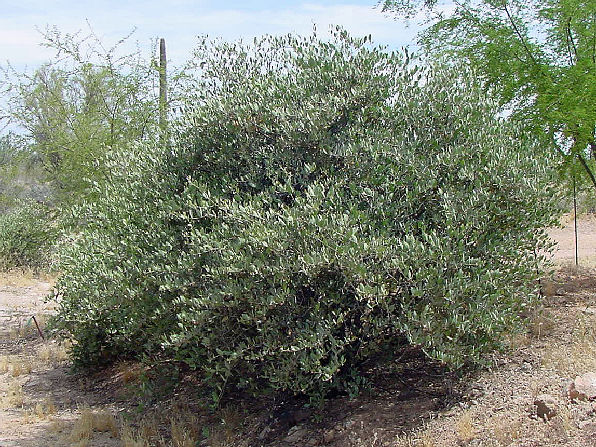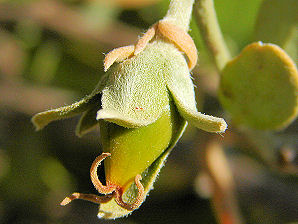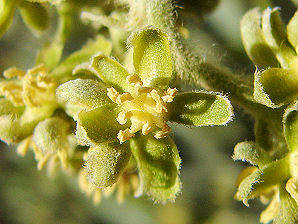Jojoba (Simmondsia chinensis,)

Family: ( Simmondsiaceae ), Jojoba. Also called; goat nut, deer nut, pignut, wild hazel, quinine nut, coffeeberry, gray box bush.
Jojoba is sometimes placed in the box family ( Buxaceae ). However, Jojoba is usually considered the single species in the Simmondiaceae family, and possibly belongs to the subclass-Hamamelididae.
Jojoba plants produce flower buds on the new summer growth. The plants must experience a certain number of chilling hours, after which the buds will mature and open in response to a late winter rain.
Jojoba is a perennial, evergreen, dioecious, wind-pollinated shrub, reaching a height of 1-5 meters and having a long life span (100-200 years). It is endemic to the Sonoran desert (south west Arizona and California, Northern Mexico and Baja California).
The Forest Service has rated Jojoba as good to very good winter browse and fair summer browse for all livestock classes. Jojoba is monecious.
The foliage provides year-round browse for many animals, especially deer, javelina, bighorn sheep, and livestock. Nuts are eaten by many animals, including squirrels and other rodents, rabbits and larger birds. However, only Bailey’s pocket mouse is known to be able to digest the wax. In large quantities, the seed meal is toxic to many mammals, and the indigestible wax acts as a laxative in humans.
Indigenous Native Americans in the Sonora and Baja California used jojoba seed and oil for cooking, hair care, and for treatments of many medical problems such as poison ivy, sores, wounds, colds, cancer, and kidney malfunction.
Morphological characters
Height: Up to about 5 - 6 feet tall as an average, but can grow up to 15 feet tall.
Flowers: Flowers are apetalous: the female ones are usually solitary, one per two nodes although flowers every node or in clusters are not rare. The male flowers are clustered. Flower buds form in the axiles of leaves solely on the new vegetative growth occurring during the warm season under favorable temperatures and water regime. New flower buds are dormant and will open only after a cool season with enough cold units for the fulfillment of their chilling requirements. Anthesis occurs in the spring when the soil and air temperature rise to above 15�C. Severe water stress prevents opening of flowers. The pale green female flowers of this dioecious species are borne singly at each leaf node. The yellowish-green male flowers are borne in clusters. Plants bloom in winter and female plants ripen their acorn-shaped and -sized seeds in summer.
|
|
Jojoba female flower |
Jojoba Male flower |
Blooming Time: Mid March - May.
Fruit: The fruit is a capsule containing one to three dark brown seeds that normally ranges in their dry weight between 0.5-1.1 g and contain 44-56% wax. Fruits ripens during the spring and early summer and seeds fall to the ground in late summer.
Leaves: Leaves are xerophytic with a thick cuticle, sunken stomata. leathery, grayish-green leathery leavesleaves.
Found: Found in Arizona and California .
Elevation: 0 - 5000 Feet.
Habitat: diverse climatic, geographic and edaphic conditions, usually on coarse, sandy or gravelly soils with good drainage. where it occupies open, sandy to rocky flats, bajadas, and playas .
Source : www.delange.org/Jojoba/Dsc00023J |



